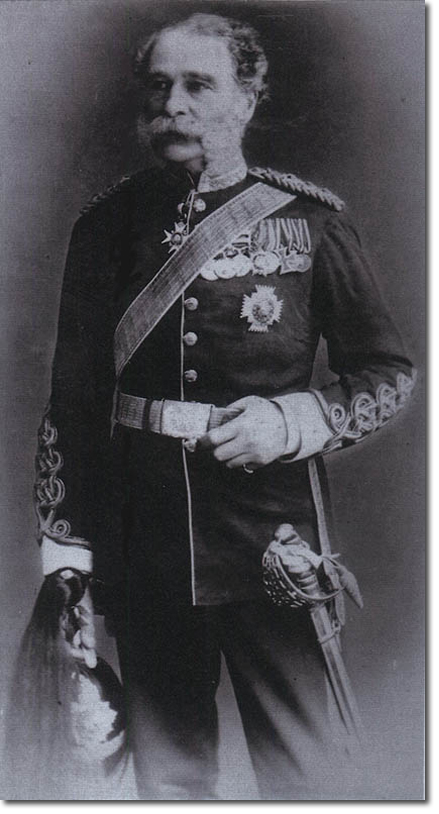|
|


|
|
Charles Pyndar Beauchamp Walker was born on 7 Oct. 1817 the eldest son of Charles Ludlow Walker JP of Redland, near Bristol, and Mary Anne, daughter of Rev. Reginald Pyndar of Hadsor, Worcestershire, and Kempley, Gloucestershire, cousin of the first Earl Beauchamp. He was at Winchester College from 1831 to 1833, and commissioned as ensign in the 33rd foot on 27 Feb 1836. He became a lieutenant on 21 June 1839, and captain on 22 Dec 1846. He served with the 33rd at Gibraltar, in the West Indies, and in North America. On 16 Nov 1849 he exchanged into the 7th Dragoon Guards.
On 25 March 1854 he was appointed ADC to Lord Lucan, who commanded the cavalry division in the Crimea. He was present at Alma, Balaclava, and Inkerman, and was mentioned in despatches. In the middle of October he was ordered on board ship for a change, and this enabled him to be present at the naval attack on Sebastopol on 17 Oct where he acted as ADC to Lord George Paulet on board the Bellerophon. He was given the medal for naval service, as well as the Crimean medal with four clasps, the Turkish medal, and the order of the Medjidie (fifth class). On 8 Dec 1854 he was promoted major in his regiment, and in anticipation of this he left the Crimea at the beginning of that month. He was appointed AQMG in Ireland on 9 July 1855, and on 9 Nov he was given an unattached lieutenant-colonelcy. On 7 Dec 1858 he became lieutenant-colonel (supernumerary) in the 2nd Dragoon Guards. He joined them in India, and took part in the later operations for the suppression of the Mutiny. He commanded a field force in Oudh, with which he defeated the rebels at Bangaon on 27 April 1859, and a month afterwards shared in the action of the Jirwah Pass under Sir Hope Grant. He was mentioned in despatches, and received the medal. From India he went on to China, being appointed AQMG of cavalry on 14 May 1860 in Sir Hope Grant's expedition. He was present at the actions of Sinho, Chankiawan, and Palikao. In the advance on Peking it fell to him to go on ahead to select the camping-grounds, and on 16 Sept, when Sir Harry Smith Parkes and others were treacherously seized during the truce, he narrowly escaped. While waiting for Parkes outside Tungchow he saw a French officer attacked by the Chinese and went to his assistance. His sword was snatched from him, and several men tried to pull him off his horse, but he shook them off, and galloped back to the British camp with his party of five men under a fire of small arms and artillery. He was mentioned in despatches, received the medal with two clasps, and was made CB on 28 Feb 1861. He had become colonel in the army on 14 Dec 1860. Having returned to England, he went on half-pay on 11 June 1861, and on 1 July was appointed AQMG at Shorncliffe. He remained there till 31 March 1865. On 26 April he was made military attache to the embassy at Berlin, and he held that post for nearly twelve years. In the Austro-Prussian war of 1866 he was attached to the HQ of the Crown Prince's army as British military commissioner. He witnessed the battles of Nachod and Koeniggratz, and received the medal. The order of the red eagle (second class) was offered him, but he was not able to accept it. He was again attached to the Crown Prince's army in the Franco-German war of 1870-1, and was present at Weissenburg, Woerth, Sedan, and throughout the siege of Paris. He was given the medal and the iron cross. The irritation of the Germans against England and the number of roving Englishmen made his duty not an easy one, but he was well qualified for it by his tact and geniality, and his action met with the full approval of the government. He was promoted major-general on 29 Dec 1873. He resigned his post at Berlin on 31 Mar 1877, and was promoted to lieutenant-general on 1 Oct. On 19 Jan 1878 he was made inspector-general of military education, and he held that appointment till 7 Oct 1884, when he was placed on the retired list with the honorary rank of general. He had been made KCB on 24 May 1881, and colonel of the 2nd Dragoon Guards on 22 Dec in that year. He died in London on 19 Jan 1894, and was buried in Brompton cemetery. He was survived by his wife who he married in 1845; Georgiana, daughter of Captain Richard Armstrong of the 100th foot. |
Armed Forces | Art and Culture | Articles | Biographies | Colonies | Discussion | Glossary | Home | Library | Links | Map Room | Sources and Media | Science and Technology | Search | Student Zone | Timelines | TV & Film | Wargames Library | Search | TV & Film | Wargames
